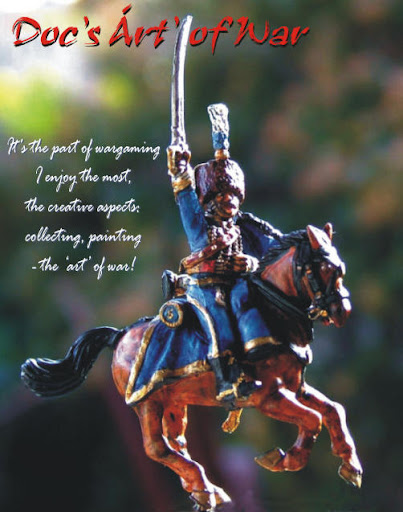Like the other casualty markers I have mounted them on a numbered card base so that each can represent up to four casualties per marker - not quite as many as a D6 dice but aesthetically much more pleasing on the game table. If I have a criticism of the Perry's it is in the quality of the finishing of their metal figures. They are a bit rough with quite a bit of casting flash on all the figures which can be quite hard to detect and clean off before painting. Fine tendrils of metal fold back on the figure and are difficult to discern. I presume this is the result of high volume casting due to the demand for them but at the end of the day it is a quality control issue that most other figure manufacturers manage to avoid. That said, they are beautiful figures and with the high level of fine detail, thoroughly enjoyable to paint. I note also that the quality of their plastic figures continues to improve - I have encountered few such problems with of the recent Perry's boxes of plastics.
In addition to finishing the 36-figure battalion of Austrian 'German' line in helmets, I also did a second battalion of Landwehr (so two full units of 32 with their mounted Oberst). I have a second battalion of helmeted German line in metal but I may take my time painting them up as there are plenty of others I have prepped and ready to go. The latest lot of metals finished are the Hungarian Grenadiers. Again, the same high quality of figure and the results you get more than makes up for the annoying casting flash and the occasional bent base (which can make an alarming crackling sound when straightened out!)
If you guessed the mounted officer in the middle doesn't look like a Perry's you'd be right. He's a conversion with an old Essex Grenadier head on a plastic Victrix mounted officer - having two mounted figures in the box of Landwehr turned out quite handy - I think he fits in quite well.
Hungarian companies were 200-240 men (German 160-80) on average, with six companies per battalion roughly 1000-1400 men which I've represented by a 24 figure unit (or 20 figures for a German battalion). Brigade sizes varied enormously so that in 1809 Kienmeyer's Reserve Division was 5 battalions strong whereas Lichtenstein's (involved in the assault on the granary at Aspen) was a huge 12 battalions. Being a heretic I have made a 32 figure battalion so they keep in roughly with the rest of my Austrian units (bugger history - its all dodgy anyway!) Actually, for Black Powder you can use battalions ranging from 24 to a massive 48 figures per unit and you'll still be historically accurate. I now have a total of 64 grenadiers with a mounted officer that I can divide into either two or three units, whichever best fits any particular wargaming scenario.
 |
| The grenadier division from IR 51 Splenyi in Grenadier Bttn Scharlach |
Nearly done - I'll finish and base them and post the results hopefully next week. I don't know what make they are (Essex maybe?) with a plastic converted figure seated behind the camel trooper second from left. Well, that's enough for now. I apologise for not looking in on many of my blogging mate's blogs over the last few weeks but I hope to make amends before the end of the month when I'm likely starting back at the daily grind again!
Cheers,
Doc











that first figure really is very vivid and realistic, Doc.
ReplyDeleteHope the part-time works brings us enough money this summer!
Great looking Camel troopers, just kicking this campaign off my self, who know's 2013-2014 the year of Napoleon in Egypt.
ReplyDeleteCheers
Stuart
Bravo on all of these, Doc. I am particularly fond of blue trousered Hungarians. The casualty group reminds me a lot of the old Airfix French infantry set. Aloha, Dean
ReplyDeleteWonderful work on these diverse figures! Austrian grenadiers are really impresive, great details!
ReplyDeletePhil.
Real life is always 'interfering' with the serious things like wargaming and painting! ;-)
ReplyDeleteImpressive figures
Rafa
A fabulous array Sir, those camels look particularly interesting.
ReplyDeleteNice work all around Doc.
ReplyDeleteSalute
von Peter himself
Why thank you one and all. Just put my Austrian Wurstkanone & limber together and was thinking I may have bitten off a tad more than I can chew. This lot is only the tip of the painting iceberg! On the plus side, I have finished the Revo French Corps de Dromidaire (or whatever they called them) which I will post soon.
ReplyDeleteCheers,
Doc
Looking lovely... As usual!
ReplyDelete